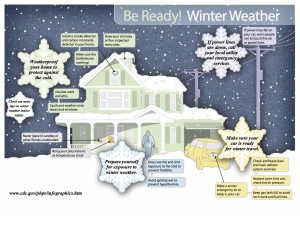Guest post by Holly Colsher, from Portlight Strategies
As the Northeast braces for what is forecast to be a historic blizzard, here are some general tips for preparing for winter weather, and some specifically for people living with disabilities:
People with disabilities may want to take extra care during the cold weather season. Some disabling conditions may limit sensory abilities and the ability to maintain body heat, so be particularly vigilant about staying warm when you are out in low temperatures.
Wear multiple layers of clothing, including a scarf around your neck, a winter hat, lined boots and two pairs of socks.
If possible, wear thermal gloves underneath mittens to keep your hands warm.
It’s also a good idea to carry a cell phone.
If you travel in a wheelchair, wrap a small blanket around your legs, tucking it underneath yourself or around your sides. This will help to maintain body heat. Wheelchair users may consider purchasing pneumatic tires for better traction. Another alternative is to use standard dirt bicycle tires. Use table salt or clay cat litter to clear ramps – rock salt can poison working assistance animals and also may be slippery. Remove the tires from your wheelchair and shake debris and ice off them before placing them in your vehicle. Wipe down any metal surfaces (wheelchair tire rims, walkers, etc.) as soon as possible after returning home. This will prevent rusting.
If you are a wheelchair user and unaccustomed to heavy, strenuous wheeling, be very careful when traveling through snow. The added exertion could lead to a heart attack or stroke. Freezing rain also will stick to surfaces such as canes, walkers, forearm cuffs and wheelchairs. Use gripper driving gloves to keep your hands warm and to prevent slipping.
If you use a working assistance dog, remember that dogs also can suffer from hypothermia and frostbite. Get a dog coat to place under the harness, and consider getting boots for the paws. Also, have a blanket in your vehicle for the dog.
Additional tips for people with disabilities:
If you receive home-based care (e.g., homecare attendant, home health aide, visiting nurse service), include caregivers in developing your plan and familiarize yourself with your homecare agency’s emergency plan.
If you are blind or have a visual disability, store a talking or Braille clock or large-print timepiece with extra batteries.
If you have a pet or service animal, also plan for his or her needs (e.g., temporary relocation, transportation, etc.).
If you rely on home-delivered meals, always stock nonperishable food at home in case meal deliveries are suspended during an emergency.
Have a plan with your doctor that addresses emergency prescription refills, if possible.
If you receive dialysis or other medical treatments, find out your provider’s emergency plan, including where your back-up site is located.
If you rely on medical equipment that requires electric power, contact your medical supply company for information regarding a back-up power source such as a battery. Follow the manufacturer’s directions when installing the equipment and the battery back-up. If you use a portable generator for emergency power, follow the manufacturer’s directions for safe operation, and check with local fire and building officials for regulations governing generator and fuel use. Ask your utility company if the medical equipment qualifies you to be listed as a life-sustaining equipment customer.
If you rely on oxygen, talk to your vendor about emergency replacements.

